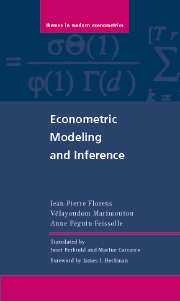12 - Stationary Dynamic Models
Summary
Introduction
This chapter is dedicated to the study of linear dynamic models, more precisely to the study of the temporal evolution of one or several variables. It is organized in the following way. The first part provides the definitions of stochastic processes in discrete time. Next, we study models that have a particular representation, namely the univariate ARMA(p, q) models. In the last part we extend these models to the multivariate setting.
Generally speaking, a stochastic process is a family of random variables on a common probability space indexed by the elements of an ordered set T which is the time index set. The random variable indexed by an element i ∈ T describes the state of the process at time i. The stochastic processes considered here are defined in the following way.
Definition 12.1A stochastic process is a family of random variables {xi, i ∈ T} where the time index set T is a subset of the real line ℝ.
We could denote by T the set of all parameters, but to avoid the confusion with the parameters in a statistical sense, we call it the time index set. It is often called the domain of the definition of the stochastic process {xi, i ∈ T}. If T is an interval of the real line, then the process is said to be a continuous-time process.
Information
- Type
- Chapter
- Information
- Econometric Modeling and Inference , pp. 261 - 303Publisher: Cambridge University PressPrint publication year: 2007
